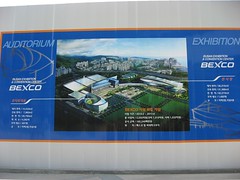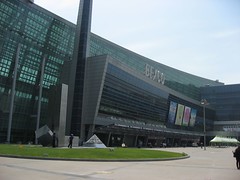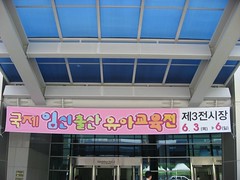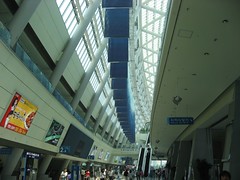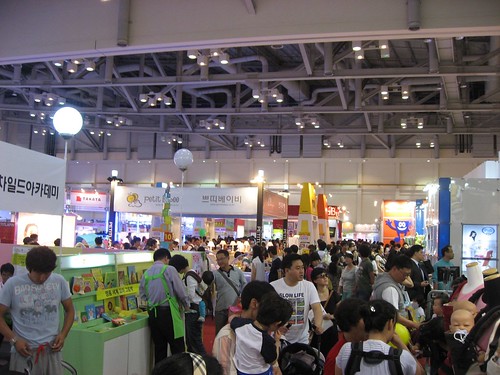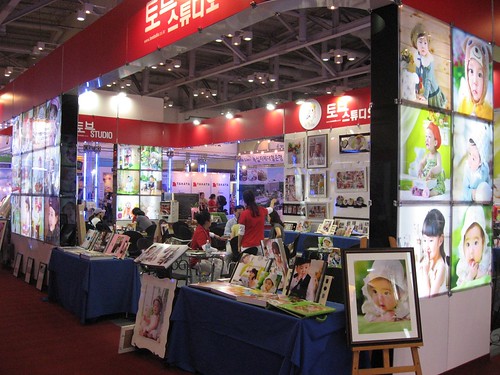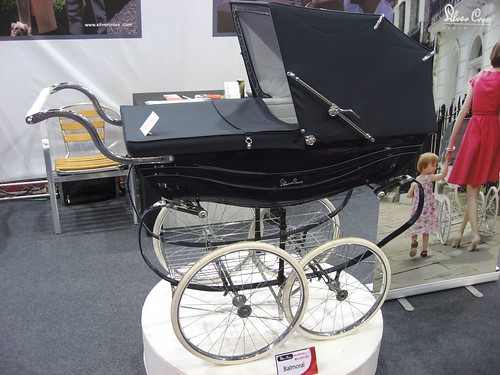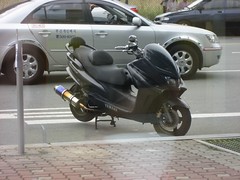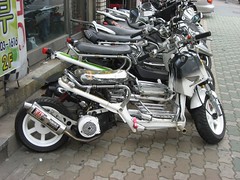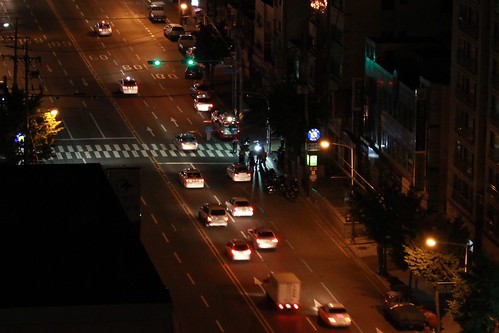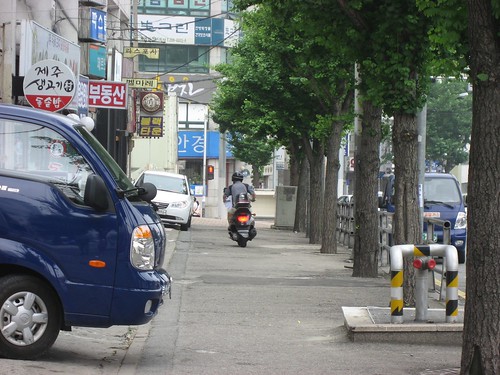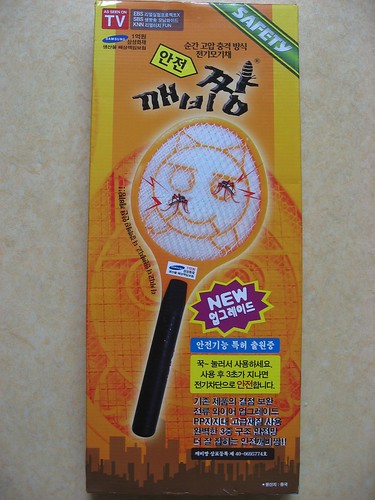For a country with a 'plunging' birthrate, it seemed somewhat optimistic to find a large baby fair being held at the Busan Exhibition and Convention Center - or BEXCO as it's known. But as this was "The 8th Busan International Baby & Education Fair" (or if you're reading the Korean, the possibly less catchy "International Pregnancy Childbirth and Small Children Education Fair"), it's almost a tradition now. And an international one at that.
So with tales of birthrate woes regularly appearing in the media, and the Samsung Economic Research Institute suggesting that the Korean race might be halved to 25 million by 2100 (with the Korean race eventually becoming extinct by 2500), it didn't seem right that when we arrived at BEXCO it would be overwhelmed with Korean parents, pregnant women and babies.
The show was a predictable mix of pushchairs, educational equipment and other products aimed at babies and expectant mothers, though there were some more Korean twists on what might otherwise be a familiar theme the world over, such as the stand offering to create "baby's first homepage". Yes, you can never get onto Cyworld and start your social networking too early...
A couple of stands were trying to entice visitors to sign up for pregnancy photo-shoots, which I learned are quite popular here. I suppose that's not so unexpected considering the enormous amount of fuss which goes into creating pre-wedding photo albums. One thing I took away from the whole wedding shoot business was the often jarring lengths people go to here to evoke a sense of period-Western romanticism that never existed in Korea, and truth be told, probably never existed in the West either, except in movies. Perhaps that's how this pram - or perambulator as it surely deserves to be called, came to be on sale at the baby fair, confounding my initial expectations that it was merely a prop:
It is, perhaps unsurprisingly, called the Balmoral, and may just find a market among Haeundae's BMW-driving royalty. Given that a significant number of Korea's pedestrian walkways are built to the usual local construction standards and seem designed to keep the local hospitals in business, it's entirely possible that the large wheels of the Balmoral perambulator may provide a smoother ride. So it may have some appeal, though it doesn't look like you'd be going anywhere in a taxi with it, and certainly not the subway. Anyway, if you wanted it, the 'show special' price was reduced from 6,000,000 won to 5,400,000 ($4,487/£2,985!)
The big surprise for me was how relatively little technology was on display. A 'magic wand' read pre-prepared stories bilingually from a book, and there were a few electronic gadgets for baby monitoring, but otherwise the most cutting edge stands were for something entirely unexpected - biotechnology - and specifically, umbilical cord stem cell extraction...
On the evidence of the number of babies and pregnant mothers at the Baby Fair, the Korean race is safe for another couple of hundred years at least, especially if those stem cells are harvested.
Monday, July 26, 2010
Tuesday, July 13, 2010
Sex & Sushi
These days Korean Brother is working his apprenticeship towards becoming a sushi chef in a large restaurant. Raw seafood of all kinds is popular in Korea, perhaps particularly in port cities such as Busan where it's possible to sit in a tent on the sea-front eating live 'sea penis' while waves wash in beneath you. In fact fish, and the smell of fish, can seem ever-present. Mixed with the frequent back-drafts from the sewage systems, it can be quite a heady mix. Sushi restaurants, are of course, everywhere.
Recently we went to a large Japanese restaurant to celebrate a family birthday, where he was not happy to discover that the resident sushi chef was a woman. “Women's hands are too warm to prepare sushi” he informed us with deep conviction. It wasn't the first time he'd said this, in fact, much like fan death, a lot of people seem to accept the notion that ideally women shouldn't be allowed anywhere near raw fish as 'common knowledge'. Dubious, I thought I would have to do some research.
It transpires that this is not merely a belief limited to the rather conservative city of Busan, because the notion appears to be shared as far away as Japanese restaurants in Canada, which probably imported it from their homeland. Warm hands and menstruation are said to be among the primary reasons.
In fact, there seems to be quite a bit of discussion on sushi preparation and warm hands, but while I was looking into the subject I discovered that despite my logical expectations, men and women's hands may indeed not generally be the same temperature. The only problem with this revelation - for male sushi-chef warm-hand theorists everywhere, is that it's actually men's hands that might be warmer.
In itself, this revelation is unlikely to shake the foundations of the Korean sushi industry, since it's a cultural feature here that well-established local urban legends almost always beat foreign scientific research for perceived factuality. However, what may be less easily dismissed, is finding a respectable Korean scientist with a paper in The Lancet stating that "women are more likely to have cold hands than men".
Sadly, my Korean language skills are not sufficient to explain to Korean Brother that, on the logic of the warm hands theory he supports, all male sushi chefs must now be replaced by women, although I don't really expect this country's poor OECD gender discrimination statistics to be challenged; after all, there's still the menstruation issue.
Recently we went to a large Japanese restaurant to celebrate a family birthday, where he was not happy to discover that the resident sushi chef was a woman. “Women's hands are too warm to prepare sushi” he informed us with deep conviction. It wasn't the first time he'd said this, in fact, much like fan death, a lot of people seem to accept the notion that ideally women shouldn't be allowed anywhere near raw fish as 'common knowledge'. Dubious, I thought I would have to do some research.
It transpires that this is not merely a belief limited to the rather conservative city of Busan, because the notion appears to be shared as far away as Japanese restaurants in Canada, which probably imported it from their homeland. Warm hands and menstruation are said to be among the primary reasons.
In fact, there seems to be quite a bit of discussion on sushi preparation and warm hands, but while I was looking into the subject I discovered that despite my logical expectations, men and women's hands may indeed not generally be the same temperature. The only problem with this revelation - for male sushi-chef warm-hand theorists everywhere, is that it's actually men's hands that might be warmer.
In itself, this revelation is unlikely to shake the foundations of the Korean sushi industry, since it's a cultural feature here that well-established local urban legends almost always beat foreign scientific research for perceived factuality. However, what may be less easily dismissed, is finding a respectable Korean scientist with a paper in The Lancet stating that "women are more likely to have cold hands than men".
Sadly, my Korean language skills are not sufficient to explain to Korean Brother that, on the logic of the warm hands theory he supports, all male sushi chefs must now be replaced by women, although I don't really expect this country's poor OECD gender discrimination statistics to be challenged; after all, there's still the menstruation issue.
Monday, July 05, 2010
Biker Boyz
Anyone who's lived here for more than a couple of weeks will probably have become used to the blatant use of pedestrian areas such as sidewalks/pavements as a more convenient off-road route. That is, as far as it's possible to learn to live with suddenly finding a large and sometimes previously unheard machine whizzing by your arm at 20mph. But lately, I've noticed that the major road outside our apartment seemed to be doubling up as a racetrack for bikers after midnight. At least, that was my theory - the enormous apparent speeds involved prevented me from getting up from my chair and reaching the window in time to actually see the physical evidence for this, even if the noise from engines and customised horns told its own story. They've also woken me up just after dawn, apparently doing racing laps of the local district, judging from the fading and crescendoing engine sounds echoing around the valley we live in.
Curious, I stopped to watch a group who I noticed were pulled into a petrol station nearby recently. It was impossible to see what kind of people they were (very young, I suspect) or what kind of bikes they had because it was too far away and too dark, but the numerous coloured LED lights on the back of their machines were unmistakable. I came back to the window a couple of minutes later as they headed off down the road with engines roaring. That's when I saw one of the rear lights wave around wildly and unmistakably crash to the floor. There was now a bike sliding along the road in a small shower of sparks, while nearby the dark shape of its former rider tumbled along next to it. I lost track of him in the darkness, but saw him again when he hit the back of a stationary car in a small cloud of smoke. I don't know what speed he was doing when he came off, but rider and machine had perhaps slid around 40 feet by the time it ended.
The ambulance came about three minutes later, and not long after that, the police arrived. I expect I'll never find out whether the rider was seriously injured. Back in England, I had a biker friend who once told me in excruciating detail of the perils of not wearing protective leathers in a similar type of accident, but here in Korea, with the temperature outside at midnight 21 degrees Celsius, what kind of clothes do these biker youths wear? Probably not the the proper gear, I expect. Laceration injuries may not be the rider's biggest problem though, given what I've since seen of other late night bikers, it's very unlikely he was wearing a helmet.
It's getting bad during the daytime as well, in a way I never really remember occurring before. It was always the case that the sensible pedestrian lets a couple of people venture out onto a crossing when the lights change to provide a target for the drivers who regularly race the lights or simply don't notice them change. But recently a couple of motorcyclists have blasted through crossings I've been at long after lights have changed and people have been mid-way across the road. A couple of days ago, I realised how deliberate this was when one rider revved his bike and speeded up as he shot through a gap in a group of rather surprised people at about 50mph. It was close enough that I could feel the rush of wind as he disappeared up the road at great pace. Sooner or later someone will, of course, get killed and then there will be some blood money to pay and maybe a bit of prison time if they're unlucky.
What seems really intended to stick two fingers up at 'the man' is ignoring the civil defence drill. I often watch these unfold below me - there's something slightly comedic about the idea that during a real attack elderly women will take to the streets and blow their whistles at both vehicles and pedestrians which don't come to a halt. Usually I see drivers try to reach the safety of side streets where they can continue their journey, or at least position themselves a few more feet down the street to cut their post-alert journey just that little bit shorter. Pedestrians meanwhile, are sometimes harangued, apparently depending on the mood of the official.
So during the last drill, for the first time, I saw someone who'd openly decided to flout it. It was, of course, a biker, who put in the following performance - if you listen carefully at the end, you can hear the whistles being blown pointlessly as he disappears into the distance:
Tags:
culture,
government,
safety,
transport
Location:
Busan, South Korea
Friday, July 02, 2010
Pong
Normally, I don't really sweat that much, and this may have been the reason why before this summer I've only had around five mosquito bites in Korea. In the last two days, I've been bitten seven times in our apartment, and I have the itchy red spots to prove it.
Having a large apartment can seem like a step up from the 'one-room' place we spent the first fifteen months in, but I discovered it had a downside: the air conditioning unit in the one-room could keep the air cool with only intermittent efforts, but the one in our four-bedroom apartment would need to stay on all the time to have any chance of making a significant difference to the temperature of our office on the other side of the building. The upshot of which is that I'm working in a room which hits 30 degrees and 80% humidity on the bad days, while three computers pump out warm air which has nowhere to go. It's hot, uncomfortable, and apparently it's made me more of a mosquito target.
The question of where the dreaded mosquitoes are actually coming from became a pressing one after their seven-bite feast. Our bed is protected by a large mosquito tent, so it isn't while I sleep. Logically then, it's almost certainly in the office where I've spent almost all my time this week. It wasn't long before careful examination of the large wire gauze cover which prevents insects flying through the otherwise open window (aka 'mogi jang' - 모기장 - mosquito net/bar) revealed it to have four large gaps in the frame where insects can enter the apartment as they wish. One of them is the gap beneath the window and the frame, which might be unavoidable, but the other three are a little inexplicable – they are lozenge-shaped holes which are clearly part of the design of the frame.
Since my wife became pregnant we can't liberally employ mosquito spray wherever we want to as we used to, and truth be told I was never convinced of its efficacy – only a direct hit at close quarters ever seemed to kill, so Korean Mother's strategy of spraying a room heavily and then closing the door for ten minutes before going to bed never seemed like it was going to harm anything apart from the person sleeping inside. I can't spray my office even if my wife isn't in the room now either, since we acquired an aquarium. So I've had to resort to using an insect swatter, which often involves cleaning up blood-splattered walls afterwards.
I hoped technology might come to the rescue, but was disappointed to find that most people on the Korean Internet felt that the kind of electrified lights which I often see in fast-food places back in the UK, but not so much in Korea, don't actually work very well. So we ended up buying an electrified mosquito swatter.
The electrified mosquito swatter seems typical of so much that is sold in Korea. It's made in China, and it's so dangerous that almost two-hundred people were injured by it last year. Shopping forums are full of cautionary tales of the huge sparks which are created and the dangers of it touching yourself or any close family members you'd like to keep. Despite this, the solution is not to ban the product, but rather to offer 100,000,000 won (£53,600/$81,500) of product liability insurance. A Samsung Insurance sticker is therefore attached above the handle for your peace of mind. If that isn't enough, the box has the word 'Safety' written in large letters in the corner, and 'As Seen on TV', though it isn't clear to me whether this was in an advert or a news report.
What kind of design aesthetic should such an apparently dangerous device have? Something that doesn't look attractive to children? No, worryingly it looks like a toy with a tennis racquet shape, a bright orange frame, and a friendly-looking cat face in the middle of the metal strings, inviting you in for a closer look.
The initial test came the day the package arrived. The device is activated with a button which must be held in while hitting the offending mosquito, although apparently it can retain a charge even after it's released. I quickly put the batteries in and pressed it – a loud crack accompanied by large retina-blurring spark immediately jumped off the metal wiring. There was no doubt this was going to be satisfyingly deadly, the only question remained as to who the victim would be. The second loud crack came as I moved the now electrified racquet gently towards the flying insect, which was left motionless in the wiring.
It's easy to be frightened by the rather cavalier attitude to public safety that exists in this country – but the electrified mosquito swatter stands as an example of how it can actually work for you; just because some ajumma set fire to her apartment with one, and just because a young girl put one in her mouth with predictably horrific consequences (yes, both actually happened), apparently nobody is going to stop you from buying it. Which is good if you're careful and responsible, but not so good if you might be Darwin Award material. Later, I'll let you know at a later time which group I fall into. Unless I can't.
Having a large apartment can seem like a step up from the 'one-room' place we spent the first fifteen months in, but I discovered it had a downside: the air conditioning unit in the one-room could keep the air cool with only intermittent efforts, but the one in our four-bedroom apartment would need to stay on all the time to have any chance of making a significant difference to the temperature of our office on the other side of the building. The upshot of which is that I'm working in a room which hits 30 degrees and 80% humidity on the bad days, while three computers pump out warm air which has nowhere to go. It's hot, uncomfortable, and apparently it's made me more of a mosquito target.
The question of where the dreaded mosquitoes are actually coming from became a pressing one after their seven-bite feast. Our bed is protected by a large mosquito tent, so it isn't while I sleep. Logically then, it's almost certainly in the office where I've spent almost all my time this week. It wasn't long before careful examination of the large wire gauze cover which prevents insects flying through the otherwise open window (aka 'mogi jang' - 모기장 - mosquito net/bar) revealed it to have four large gaps in the frame where insects can enter the apartment as they wish. One of them is the gap beneath the window and the frame, which might be unavoidable, but the other three are a little inexplicable – they are lozenge-shaped holes which are clearly part of the design of the frame.
Since my wife became pregnant we can't liberally employ mosquito spray wherever we want to as we used to, and truth be told I was never convinced of its efficacy – only a direct hit at close quarters ever seemed to kill, so Korean Mother's strategy of spraying a room heavily and then closing the door for ten minutes before going to bed never seemed like it was going to harm anything apart from the person sleeping inside. I can't spray my office even if my wife isn't in the room now either, since we acquired an aquarium. So I've had to resort to using an insect swatter, which often involves cleaning up blood-splattered walls afterwards.
I hoped technology might come to the rescue, but was disappointed to find that most people on the Korean Internet felt that the kind of electrified lights which I often see in fast-food places back in the UK, but not so much in Korea, don't actually work very well. So we ended up buying an electrified mosquito swatter.
The electrified mosquito swatter seems typical of so much that is sold in Korea. It's made in China, and it's so dangerous that almost two-hundred people were injured by it last year. Shopping forums are full of cautionary tales of the huge sparks which are created and the dangers of it touching yourself or any close family members you'd like to keep. Despite this, the solution is not to ban the product, but rather to offer 100,000,000 won (£53,600/$81,500) of product liability insurance. A Samsung Insurance sticker is therefore attached above the handle for your peace of mind. If that isn't enough, the box has the word 'Safety' written in large letters in the corner, and 'As Seen on TV', though it isn't clear to me whether this was in an advert or a news report.
What kind of design aesthetic should such an apparently dangerous device have? Something that doesn't look attractive to children? No, worryingly it looks like a toy with a tennis racquet shape, a bright orange frame, and a friendly-looking cat face in the middle of the metal strings, inviting you in for a closer look.
The initial test came the day the package arrived. The device is activated with a button which must be held in while hitting the offending mosquito, although apparently it can retain a charge even after it's released. I quickly put the batteries in and pressed it – a loud crack accompanied by large retina-blurring spark immediately jumped off the metal wiring. There was no doubt this was going to be satisfyingly deadly, the only question remained as to who the victim would be. The second loud crack came as I moved the now electrified racquet gently towards the flying insect, which was left motionless in the wiring.
It's easy to be frightened by the rather cavalier attitude to public safety that exists in this country – but the electrified mosquito swatter stands as an example of how it can actually work for you; just because some ajumma set fire to her apartment with one, and just because a young girl put one in her mouth with predictably horrific consequences (yes, both actually happened), apparently nobody is going to stop you from buying it. Which is good if you're careful and responsible, but not so good if you might be Darwin Award material. Later, I'll let you know at a later time which group I fall into. Unless I can't.
Location:
Busan, South Korea
Subscribe to:
Posts (Atom)
